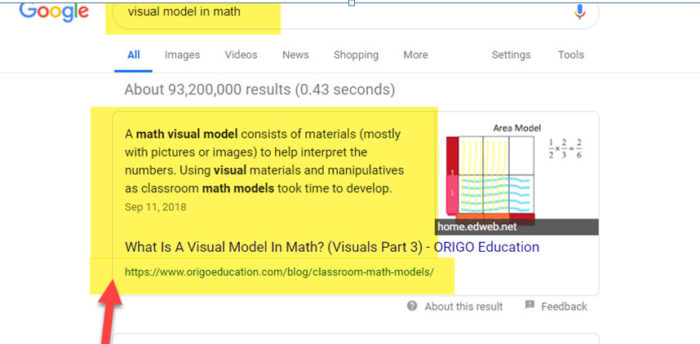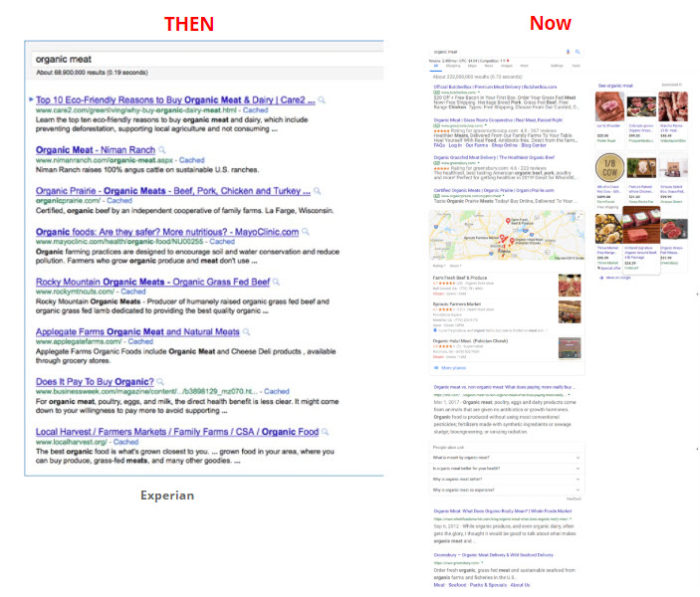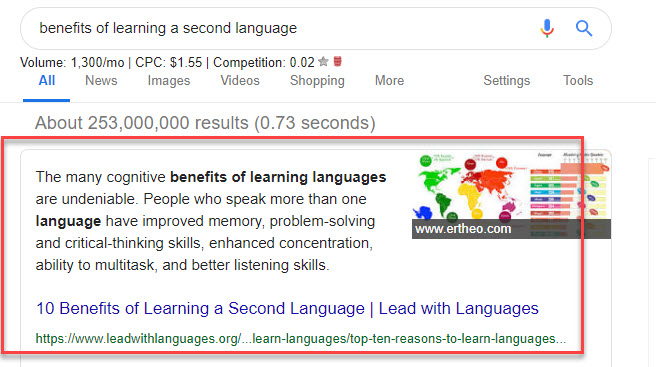To say Google has evolved over the years is putting it mildly.
So if you’re still doing the same things you did 5 years ago, you’re going to be in trouble (if you’re not already). Years ago, everyone was asking: “how do I rank in Spot 1”? Today, the question is “how do I rank at Position 0”?
What is Position 0?
Position 0, at its most basic definition, is an element in the SERP (search engine results page); it’s a box containing text that directly answers a query.

Although a link to the content is provided, its goal is to provide users with a concise, direct answer to the question right on the search results page without having to click through.
Definition and Distinction: A Featured Snippet vs. a Rich Snippet
Position 0 is also commonly referred to as a Featured Snippet. They are synonymous.
However, because of the confusion with the SEO term “Rich Snippet,” I prefer to eliminate any ambiguity by calling a Featured Snippet by its street name: Position 0.
What is a rich snippet? A “rich snippet” is a term used to describe an enhanced result in the SERP, often achieved through adding structured data code to the HTML in the back end. Examples include product star ratings and reviews under ecommerce product results, event listings, recipe markup, local carousel results, etc.
A featured snippet (Position 0) is what I explained above: a box with a link, an image, and a snippet of content that directly answers the user query. It has NOTHING to do with schema or structured data.
So for all intents and purposes, we’re going to refer to the SERPS box element as Position 0 from here on out.
2 Important Reasons Why Your SEO Strategy Should Include Targeting Position 0
Before we get into HOW you rank for Position 0, let’s first talk about WHY you should care about ranking in Position 0. There’s more to it than just vanity rankings. While it has multiple benefits, here are 2 of the most critical reasons you should make targeting Position 0 part of your ongoing SEO strategy:
- Evolving SERPS and click behavior
- You can leverage the content you already have
1. Evolving SERPS and Click Behavior
Do you remember back in the day when the SERPS was mostly compromised of 10 little blue links? Nowadays, the SERPS looks completely different and has evolved tremendously. Here is a “Then” and “Now” of results that pull up for the search phrase, “organic meat”:

A smidge different, right?
For many years now, we SEOs recognized that even with Page 1 rankings, click through to organic listings has been decreasing. I’ve been seeing this trend in the data of SEO reports for years. Page 1 rankings for organic listings is not enough. And this is especially true in mobile – you have to scroll down quite a way before you get to organic web results.
The evolving diversity of the SERPS – and how searchers are interacting with the content presented – is behind the required SEO strategy addition of Position 0.
Beyond targeting Position 0 – how else should you adapt your SEO strategy?
You must diversify and plan for what content is the best match for the user query search intent. Here are additional content areas you must also focus on if you want to win the click away from competitors:
- Image SEO – how often do we see rows of images at the top of the SERPS? Compress your images, optimize the file name, provide thoughtful, optimized alt text when possible, and make sure the text surrounding your images is complementary and optimized
- Videos – video thumbnails from YouTube are often ranking at the top of the rankings, particularly for “how to” and “DIY” searches. Make sure videos are part of your strategy, and that you’re optimizing your off-site content just as well as your on-site content
- Google Ads – you can’t escape them. Google has been prioritizing Ads by giving them premium real estate on the SERPS. And as much as other marketers tell me they hate ads, I remind them that what people say and do are often different. They can be very effective and give the desired prominent visibility for important terms – you just have to be prepared to pay.
- Map and Local Listings – for years now, Google has started localizing search results with a Google map and local listings present either at the top or halfway down the SERPs. I’ve noticed for one of my clients, many of their previously non-geographically targeted terms, such as “nut corporate gifts” and “organic pecans” now pull up map results.
- PAA – the PAA boxes, (People Also Ask), is an extension of Position 0. Most of the time it takes up a sizable chunk of Page 1 and is present for the vast amount of search results I see daily. What I wonder, is what came first: the chicken or the egg? Has Google lead the way to shape our search behavior by utilizing these more, or is Google’s increasing placement of PAA boxes a reflection of what searchers desired first and Google just stepping up to the plate? We may never know. Regardless, they’re here to stay.
Those are only a few of the many different SERPS results you see today. For a more comprehensive list, check out this Moz article.
2. Leverage Content You Already Have
Position 0 – many times – leverages what you already have. It’s a way to get more traffic and clicks without necessarily creating brand new content or acquiring new backlinks.
I can point to several instances over the past for years where I’ve jumped onboard with a client and helped clients gain several Position 0 results without purposefully targeting for Position 0. This has happened naturally as a byproduct of taking well-written, authoritative content and applying proper on-page optimization and keyword targeting.
For example, a few years ago I worked with one organization who was a leader in their space advocating and educating about the importance of language learning. They had one article that was core to their site and prominently featured, but I could tell SEO had not been a factor when writing or publishing it. It was first on my list of many URLs that I needed to optimize. I remember optimizing this post, which started slowly moving up the rankings onto Page 1. A few months later, while preparing my monthly SEO report, I noticed a significant jump in clicks.
Check out the data below: yes, the result had moved up two additional spots on Page 1 (from spot 7 to spot 5), but incremental gains like that don’t generally result in clicks increasing by 300% and a CTR increase of 200%:

Sure enough, upon opening up an incognito browser window and typing in the keyword, I saw our Page 1 ranking had moved into the Position 0 spot:

Our CTR went through the roof, and is continuing to hover at 30%.
I see this constantly – incredibly higher than average CTRs for content that has keywords ranking at Position 0. Here is another client who, upon gaining the coveted Position 0 spot, saw CTRs jump up dramatically:

Part 2: How Do You Optimize for Position 0?
Do I have you convinced? Wondering how do you begin to target the gloriousness that is Position 0? Check out this guide to learn how to rank at Position 0.
Stayed tuned for the next article where we get into the specifics of HOW you rank for Position 0 and what some handy tools are (free and paid) that you can use along the way.
Jenny Munn
Latest posts by Jenny Munn (see all)
- Four 2024 SEO Planning Tips for World Domination - November 16, 2023
- SEO Planning Tip: Why You Need a CYA Clause - November 3, 2023
- How Long Does SEO Take to Show Results? (Updated for 2023) - August 9, 2023


